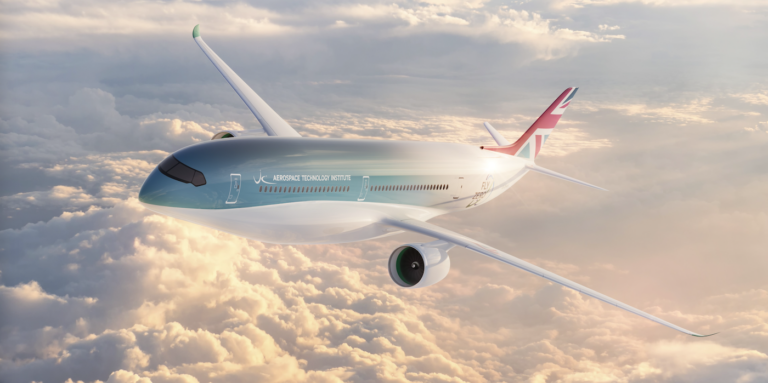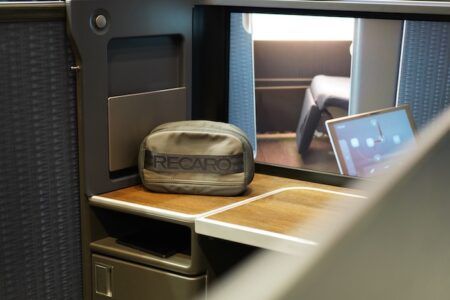In a linear economy, industries produce or extract raw materials from nature, convert them into products, and then discard them as waste. This contributes to climate, biodiversity and pollution issues. However, a suitable foil for this is to embrace a circular economy. So how can carriers and suppliers incorporate aerospace circularity to achieve sustainability goals?
What is aerospace circularity?
Aerospace circularity, also known as circular aviation or a circular economy, is a way of designing, making, and using products within planetary boundaries (boundaries within which humanity can continue to develop and thrive, according to Stockholm University) or to maintain the stability of earth. As such, recirculating products rather than discarding them after use minimises waste and greenhouse gas emissions.
A circular economy would encourage aviation to produce high-quality aircraft cabin interiors while minimising the demand for natural resources. Circularity promotes the use of materials in a continuous cycle, mirroring natural processes and eliminating the need for additional input or waste.
How does circularity relate to the cabin interiors industry?
Aerospace circularity influences how aircraft cabin components and designs are developed, produced, maintained, and disposed of.
In FlyZero’s bespoke circular economy model for the cabin sector, for example, it was shown that only part of the industry is practicing circularity by recycling materials into other industries, refitting them onto other aircraft, or selling them to other operators during the end-of-life stage. [more details HERE]
The lack of appropriate material marking or data sharing between OEMs, airlines and recyclers is one barrier to the effective realisation of circularity. Material marking helps OEMs, airlines and recyclers identify the types of materials used throughout the cabin product life cycle. Some materials are more volatile, making material marking even more important. Data transparency across the cabin product life cycle will help the industry find cost-effective materials that can be recycled.
As Sandra Bour Schaeffer, Airbus’s SVP of procurement for cabin and cargo states,“Life cycles are much shorter in the cabin, and there are structural solutions that can be implemented right now.”
Branding is also a challenge, as nearly half of cabin interiors are customised. To apply aerospace circularity, airlines can homogenise the designs for cabin furniture in all classes, helping enable re-customisation if the cabin products are sold again. This approach minimises the manufacturing impact of customisation, while maximising experiential differentiation for the customer.
Circularity must be integrated into the whole cabin industry’s business models at scale, not just to individual cabin OEMs. Moreover, the industry should consider what to do during end-of-life scenarios and how to maintain cabin products in the higher-value phases of their lifecycles.
Aerospace circularity is crucial to cabin interiors, particularly when selecting aircraft cabin structures. Recycling cabin materials can sometimes lead to inconsistent structural and visual performance, which makes them unfit for in-flight application by authorities. The industry needs to develop strategies and certification approaches that will not limit the use of recycled cabin interiors.

Why is aerospace circularity important?
Aerospace circularity helps give the aviation industry a holistic lifecycle view. This, in turn, will allow for the development of an infrastructure that will support sustainable activity and look for new recycled materials and solutions for the market.
Cabin interiors are resource-intensive, and circularity promotes resource efficiency, longer lifespans, and easier repair and refurbishment. Aerospace circularity also helps the sector comply with sustainability requirements and minimises costs.
Circularity is a key enabler for a more sustainable cabin. It involves responsible management of materials, design, manufacturing, operations, and end of life. It allows for a common lifecycle assessment baseline and comparisons, consolidating data and tools for sustainability standards.
What are airlines/suppliers doing?
Aviation has been exploring various circular economy principles.
Gatwick Airport, for example, converts organic waste into biomass fuel, while Torino Airport cultivates chamomile in its green areas to promote biodiversity and minimise the risk of wildlife strikes.
The Dutch airport company, Royal Schiphol Group (RSG), has several circularity programmes, one of which is its collaboration with Philips, wherein airport lights will be given to them during the end-of-life phase for recycling.
Cabin interior suppliers are also adhering to aerospace circularity. Diab Group has developed a thermoplastic sandwich panel for aerospace cabin interiors that is 100% recyclable. Meanwhile, Huntsman and V-Carbon Technologies have joined forces to recover carbon fibre material systems that could be integrated into existing manufacturing platforms.
Recycling aluminium from decommissioned aircraft and reintegrating it in the aerospace value chain is the goal of Constellium SE and TARMAC Aerosave’s partnership.
Adient Aerospace, a joint venture between Boeing and automotive seating manufacturer, Adient, employs thinner and lighter materials to improve fuel efficiency. Boeing uses crop flax on its sustainable wall panels, which can also be applied in manufacturing seat shells, aircraft cabin walls, and other elements. Airbus reduces the environmental impact of the cabin interior supply chain through smart digital solutions, like the Internet of Things.

Attaining sustainable aviation through aerospace circularity
Aerospace circularity is an approach that relies on the extraction of the maximum value from resources in use and keeps materials in circulation for as long as possible. It is being applied in aviation, from converting waste into biomass fuel to using materials complemented by recycling strategies.
Cabin interior suppliers are also practicing circularity, like recovering carbon fibre and aluminium.
While circularity in aviation is valuable, it still comes with challenges, such as significant upfront investments, and difficulties in finding recyclable materials that meet aviation safety and performance standards.
FlyZero adds that the cabin is one of the most difficult parts of an aircraft in which to apply circular economy principles, because it requires intra-sector and cross-sector partnerships. Currently, the industry lacks material and product flows at viable scales. OEMs also rely mostly on less eco-friendly designs and materials.
If it is to achieve sustainable aviation, the industry needs to develop more efficient and consistent solutions to reduce environmental impact without sacrificing passenger comfort or economic growth. While some sustainability efforts are underway, there is a lack of green action in end-of-life solutions, maintenance, operations, and production.
Aerospace circularity is poised to address environmental challenges, not only in in-flight operations, but also in the production of air vehicles and cabin interiors.
There will be a wide range of sustainable ideas and designs on show at Aircraft Interiors Expo, taking place at Hamburg Messe on 28-10 May.





